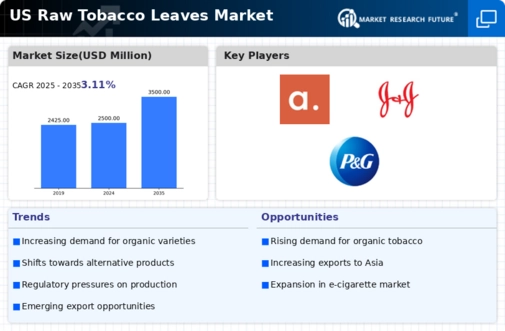Regulatory Landscape and Compliance
The regulatory landscape surrounding the raw tobacco-leaves market is complex and continually evolving. Stricter regulations regarding tobacco production and sales are being implemented at both state and federal levels. Compliance with these regulations is crucial for market participants, as non-compliance can lead to significant financial penalties. For instance, recent changes in labeling requirements have necessitated adjustments in production processes for many growers. While these regulations may pose challenges, they also create opportunities for companies that prioritize compliance and transparency. As the industry adapts to these regulatory changes, the raw tobacco-leaves market may see a consolidation of players who can effectively navigate this landscape.
Rising Demand for Value-Added Products
The raw tobacco-leaves market is witnessing a rising demand for value-added products, which are often perceived as premium offerings. Consumers are increasingly interested in products that provide unique experiences, such as flavored tobacco leaves or specialty blends. This trend is supported by market data indicating that value-added tobacco products account for nearly 25% of total tobacco sales in the US. As manufacturers respond to this demand by innovating and diversifying their product lines, the raw tobacco-leaves market is likely to experience growth. This shift towards value-added offerings may also encourage investment in research and development, further enhancing the market's potential.
Export Opportunities in Emerging Markets
The raw tobacco-leaves market is poised to benefit from expanding export opportunities in emerging markets. Countries in Asia and Africa are witnessing a surge in demand for tobacco products, driven by increasing disposable incomes and changing consumption patterns. For example, the export of raw tobacco leaves from the US to these regions has seen a growth rate of approximately 10% over the past year. This trend suggests that US producers may find lucrative markets abroad, thereby enhancing their revenue streams. As international trade agreements evolve, the raw tobacco-leaves market could experience further growth through increased access to these burgeoning markets.
Consumer Preferences for Natural Products
The raw tobacco-leaves market is experiencing a shift in consumer preferences towards natural and organic products. As health-conscious consumers increasingly seek alternatives to synthetic additives, the demand for unprocessed tobacco leaves is likely to rise. This trend is reflected in the growing popularity of hand-rolled cigars and natural tobacco products, which are perceived as healthier options. According to recent data, the market for organic tobacco has expanded by approximately 15% annually, indicating a robust interest in natural tobacco offerings. This shift in consumer behavior is expected to drive growth in the raw tobacco-leaves market, as manufacturers adapt their product lines to meet these evolving preferences.
Technological Advancements in Cultivation
Technological advancements in agricultural practices are significantly impacting the raw tobacco-leaves market. Innovations such as precision farming, which utilizes data analytics and IoT devices, enable farmers to optimize crop yields and reduce resource consumption. These advancements not only enhance the quality of tobacco leaves but also contribute to sustainable farming practices. For instance, the implementation of automated irrigation systems has been shown to increase efficiency by up to 30%, thereby improving profitability for growers. As these technologies become more widespread, they are likely to bolster the raw tobacco-leaves market by ensuring a consistent supply of high-quality products.

















Leave a Comment